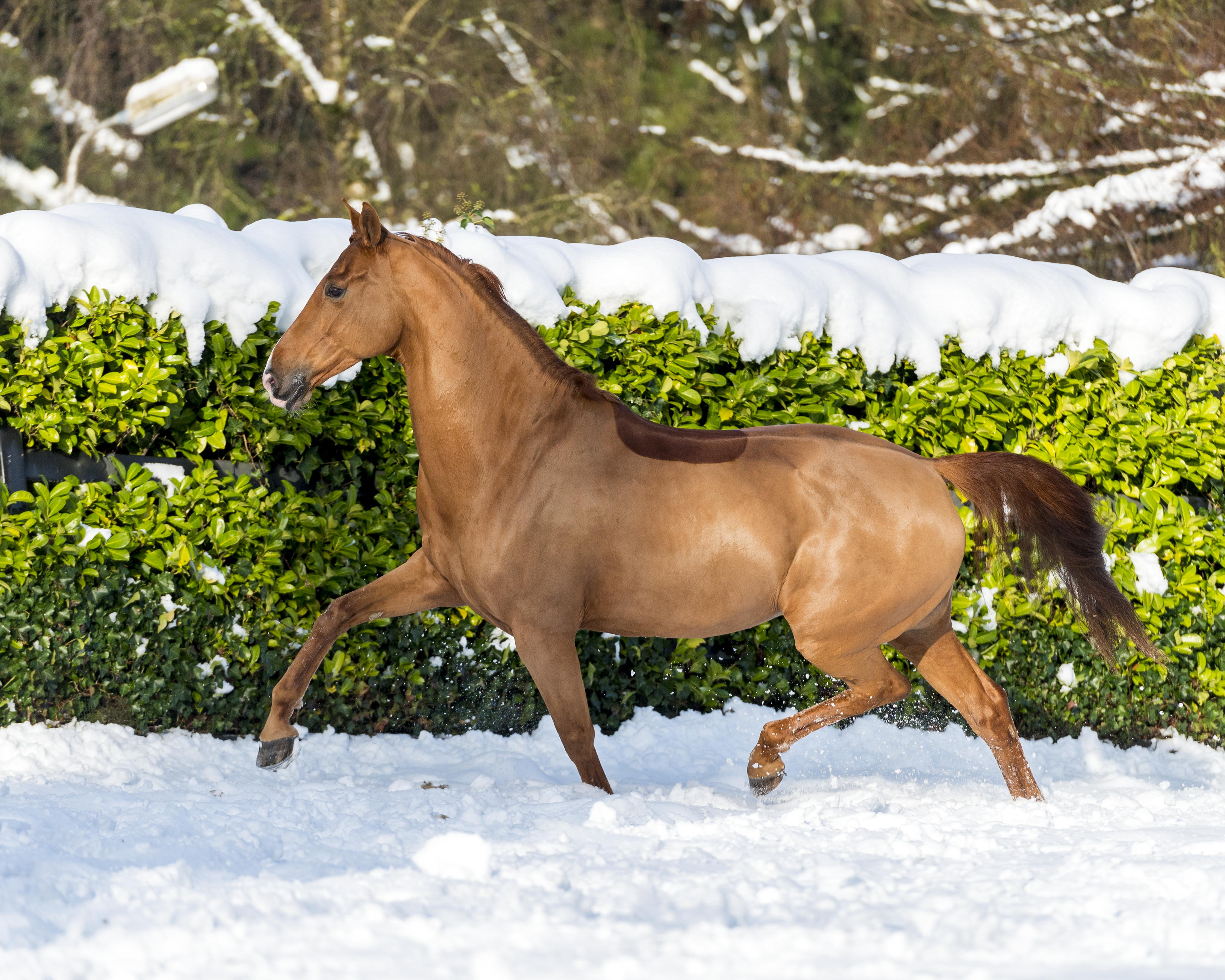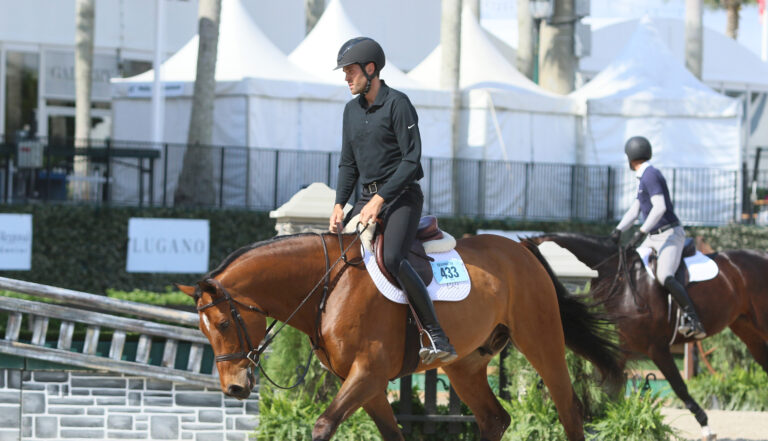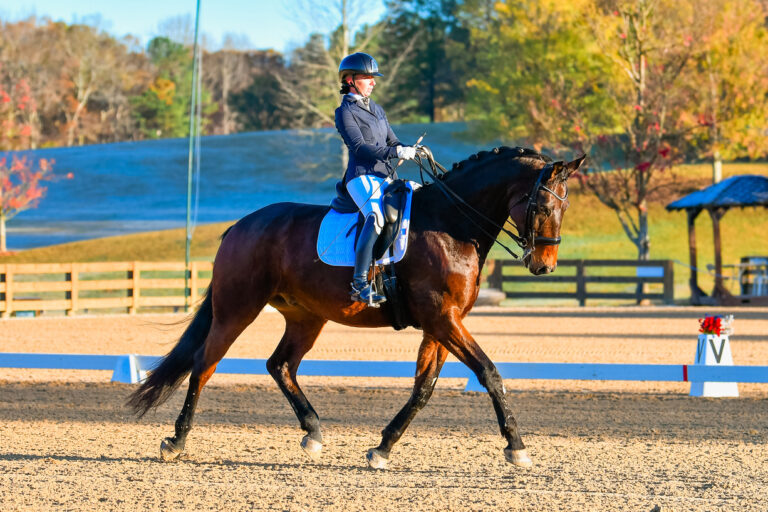
Questions lead to answers, but answers always lead to more questions. For example, last month I mentioned that course designers plan their courses based on a 12-foot stride. That’s the correct answer, and I was satisfied with it—until I heard from the “yeahbuts.”You know: “Yeah, but Jim … is that true in every situation?” Of course, my answer to that has to be, “Well … er … ahh, no, not really.”
Your horse’s stride can be affected by footing, terrain, size of the arena, fatigue, your technique (good or bad) and a host of other factors. Designers take all these into account when planning their courses. For example, a show-jumping course designer might not include a big oxer-to-oxer combination late in a long course; a tired horse could get “hung up” on the back rail of the second oxer. Cross-country course designers might allow for fatigue in building their last few obstacles—for example, by constructing the last combination out of brush rather than solid elements. A fatigued horse can blunder badly at such a fence, yet land safely on the other side.
Another factor in stride length is, of course, your horse. His ability to control and change his stride is wonderful. Olympic gold medalist David O’Connor says a horse can do anything with his body he wants to do. The next time you turn a fresh, enthusiastic young horse out in a paddock, stick around and watch the show. You are about to see the foundation of classical training on display. You might see passage, piaffe, extended trot and canter, flying changes, pirouettes and—if he is feeling really good—levades and caprioles.
Hey, Speaking of Classical Training …
My definition of “classical” is that we do not ask our horse to do anything that he does not do in nature. What would “non-classical” look like? For example, a horse can naturally bite at a fly on his chest during an extended trot movement—but he will then open the angle of his throat again, placing his nose at, or just in front of, the vertical. Forcing him to consistently hold his chin on his chest is unnatural, and thus “rollkur” is non-classical and physically damaging to the horse.
Another non-classical pet peeve of mine: tight nosebands. The relaxed horse is mobile in his jaw. Tight nosebands of whatever variety prevent this mobility and place your horse in an unnatural state. Horses in an unnatural state are tense, thus once the noseband restricts the mobility of the horse’s jaw, the rider is creating tension in the horse. The mirror of a human’s soul is in his or her eyes, but the mirror of a horse’s soul is in his mouth.
When I say this at clinics and lectures, I quite often get a “yeahbut” that someone’s horse “goes better” in a crank or tight flash noseband. As an alternate view of their universe, I always offer my version of the placebo effect. Especially with younger or less-skilled riders, I can almost guarantee that if I change their snaffle from a loose ring to a flat ring, or vice versa, and tell the rider “he will go better in this bit,” chances are he will go better. But it is not really about the bit, it is about the rider’s attitude toward the bit. If the rider relaxes, thinking her horse is going to go well, the horse will sense this—and go better.
.jpg)
© Amy K. Dragoo/AIMMEDIA
‘Elite,’ Fine—But Not ‘Almost Impossible’
A little observation suggests that David is right: What your horse does is pretty amazing, but just because your horse can do something does not mean that our sport should ask him to do it.
Thoughts like this go through my mind every spring as I drive through the lovely horse farms that surround the Kentucky Horse Park. The Land Rover Kentucky Three-Day Event is always the best event of the year, and there is a great deal going on outside the arena as well as in the competition. All the eventing silverbacks in attendance study the results from each phase, identify trends and argue about where the sport should go from here.
One discussion topic that is starting to surface is the ever-increasing technical skill that elite eventing requires. The lower number of entries at both Kentucky and Badminton this spring probably heightens this concern. I share the misgivings about overly technical requirements (and I will return to this in a minute), but I think this spring’s lower numbers were an anomaly. I am confident that we will see a resurgence in the entries at Kentucky, and it is hard to believe that England would be cursed with another incredibly wet spring; most of the preparatory competitions before Badminton 2018 were rained out.
Having said that, I believe it is fair to ask whether we have increased the required skill level so much as to preclude people from thinking that riding at the four-star level is possible for them. I am conflicted about the “expertise creep” that is happening at the upper levels. On one hand, we want the elite levels of our sport to be, well, elite. But as I just said, even though it is possible for horses and riders to do something, that does not mean they should.
There was a political scuffle in the international eventing world a few years ago when the international rules committee suggested that flying changes in three-time (changing lead every third stride) should be included in the four-star dressage test. Fortunately, wiser heads prevailed and the rule change was never introduced. If we were to follow that logic to an illogical (in my view) conclusion, then at some point in our dim and distant future it would seem appropriate to introduce passage and piaffe into the dressage test. In that case, an argument could be made that since dressage would then outweigh the other two phases in importance, we should increase the heights and spreads of the show jumping. And so on.
The problem with expertise creep is that with every substantial change in the sport, we increase the time needed for both horse and rider to become adept at the new requirement. When recently asked about the career path for someone who wished to ride at the four-star level, an elite rider basically said to find a nice young horse, put yourself in the hands of an expert coach and devote the next 10 years of your life to that goal. When a sport requires that much time and technical skill, it narrows the potential entries as well as talent.
.jpg)
© Amy K. Dragoo
Change Produces Change
As we examine expertise creep, we also need to be aware of the ripple effect of the technical questions currently asked of our horses, especially in the cross-country courses. As a cross-country designer introduces new ideas, riders and trainers adjust their training practices to remain competitive. I am continually fascinated by the cat-and-mouse game between riders and trainers on one hand and cross-country course designers on the other. You can guarantee that whatever obstacle or terrain feature appears on a big-time course will soon be reproduced at the rider’s training facility. By the time horses get to the four-star level, they will have practiced over most of the questions asked by designers. They just have to do the same thing they practice at home, only this time in front of thousands of people.
While cross-country courses have become more complex in recent years, they have also become more mechanical. In the past it has been common for coaches to tell their riders “this first part of the combination will ride in four strides and then a three to the last jump.” Good designers hate this because it reduces the course to an exercise in counting numbers rather than the riders’ feeling and reacting to their horses’ strides.
Fortunately, this trend is disappearing. For example, in Kentucky this year, it was still quite common to see obstacles in relation to each other, but those combinations also contained curves on terrain, which increases the complexity of the designs exponentially. I am now calling these problems “reactive distances” rather than “related distances” because a rider must jump into the distance to know how many strides to take in order to jump out successfully. I view this as a good thing because it places the emphasis on feel and good horsemanship rather than on mechanical recitation of predetermined strides. After all, we are supposed to be horsemen, not mathematicians.
An unexamined trend in cross country is not that our cross-country combinations are increasingly complicated these days; it is that as designers have become more inventive and complex in the design of their cross-country combinations, the reaction time afforded horses and riders between obstacles has become shorter and shorter. As designers ask for a more immediate response from the horses and riders, riders and trainers are increasingly turning to gadget bits to provide that instantaneous response. (For me, anything more than either a flat-ring or a loose-ring snaffle is a gadget bit.)
A question frequently asked of me is why riders in the Classic era usually rode in snaffles. Typically, my answer has multiple parts. I am a big fan of the Classic format, especially because of the horsemanship lessons it entails. However, all was not sweetness and light during the Classic era. While it provided the ultimate test of horse and rider, it also provided an ugly picture when horses and riders failed the test. Watching exhausted horses and riders attempting to jump dangerous obstacles was not an edifying spectacle. Cross-country courses of that era were primarily tests of courage, balance, fitness and attitude. We did not have to make sharp turns or lengthen and shorten our horses’ strides, so we did not need anything more than a snaffle. Times have changed and attitudes toward bits have changed along with them.
Once again, we must ask ourselves an important question: Just because a horse can do something, should we ask him to do it? Our bitting rules are quite detailed for the dressage phase with the intent of encouraging correct training rather than allowing shortcuts through the use of exotic hardware. It may be that in the future, we need to pay closer attention to the questions that cross-country designers ask of horses and riders and pay equal attention to the methods that riders and trainers use to answer those questions. We need to take a close look at our evolution as a sport and develop a vision of what we want our future to look like. Our horses are in our care and we need to think about them first in every discussion. We may forget to think about future generations, but they will not forget us. They will be forced to consider our actions—and if we get it wrong, they may not forgive us.
This article was originally published in the September 2018 issue of Practical Horseman.











